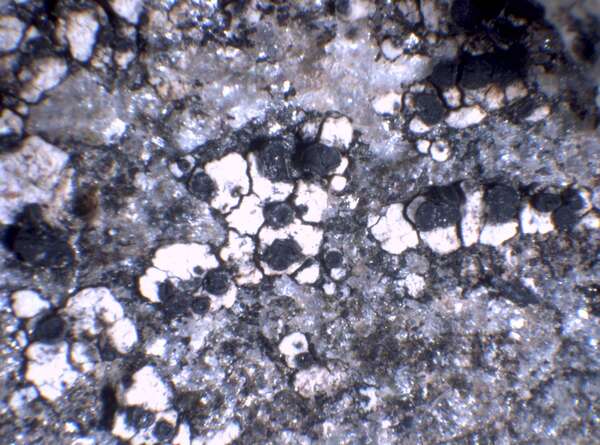Carbonea atronivea (Arnold) Hertel
Mitt. bot. Staatss. München, 19: 375, 1983. Basionym: Lecidea atronivea Arnold - Flora, 53: 123, 1870.
Synonyms:
Distribution: N - Ven (Hertel 2001, Hertel & Schuhwerk 2010), TAA (Hafellner 2021, Nascimbene & al. 2022), Piem (TSB 33159), VA.
Description: Thallus crustose, episubstratic, pure white, continuous or slightly rimose to areolate, to 1.5 mm thick, forming small, 3-20 mm wide orbicular patches. Medulla white, I-. Apothecia lecideine, usually in clusters, black, epruinose, somewhat glossy, slightly immersed to adnate, at first rounded, then angular by mutual compression, 0.2-1.3 mm across, with a flat to slightly convex, rarely umbonate disc, and a thin, raised, often undulate proper margin. Proper exciple black, reddish brown only in innermost and lowermost parts, with red-brown lines towards hypothecium (visible on thin sections); epithecium blue-green or emerald-green, 20-30 µm high; hymenium colourless or pale green in upper part, 50-65 µm high; paraphyses simple, conglutinated, forked and anastomosing in upper part, 1.5-2 µm thick at mid-level, the apical cell slightly swollen, to 3.5 μm wide; hypothecium dark reddish brown, K-. Asci 8-sporedclavate, the K/I+ blue tholus penetrated by a faintly amyloid apical cushion with parallel or diverging flanks, the outer wall very thin, K/I-, surrounded by a K/I+ blue outer layer, Lecanora-type. Ascospores 1-celled, hyaline, oblong-ellipsoid, (6-)8-15 x 3-7 µm, rather thick-walled. Pycnidia black, globose, immersed. Conidia thread-like, 20-35 µm long. Photobiont chlorococcoid. Spot tests: thallus K- or K+ faintly lemon-yellow, C-, KC-, P-. Chemistry: cortex with traces of atranorin, or without lichen substances.Note: an arctic-alpine, circumpolar species found on lime-containing siliceous rocks (e.g. calciferous schists) near or above treeline, starting the life-cycle on species of Lecidella; certainly overlooked and more widespread in the Alps.
Growth form: Crustose
Substrata: rocks
Photobiont: green algae other than Trentepohlia
Reproductive strategy: mainly sexual
paras Lecidella spp. when young
Commonnes-rarity: (info)
Alpine belt: rare
Subalpine belt: very rare
Oromediterranean belt: absent
Montane belt: absent
Submediterranean belt: absent
Padanian area: absent
Humid submediterranean belt: absent
Humid mediterranean belt: absent
Dry mediterranean belt: absent

Predictive model
Herbarium samples
Growth form: Crustose
Substrata: rocks
Photobiont: green algae other than Trentepohlia
Reproductive strategy: mainly sexual
paras Lecidella spp. when young
Commonnes-rarity: (info)
Alpine belt: rare
Subalpine belt: very rare
Oromediterranean belt: absent
Montane belt: absent
Submediterranean belt: absent
Padanian area: absent
Humid submediterranean belt: absent
Humid mediterranean belt: absent
Dry mediterranean belt: absent

Predictive model
| Herbarium samples |
 Index Fungorum
Index Fungorum
 GBIF
GBIF




